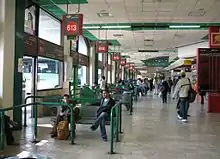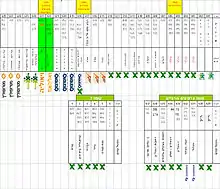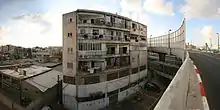Tel Aviv central bus station
Tel Aviv central bus station, also known as the new central bus station (התחנה המרכזית החדשה, HaTahana HaMerkazit HaHadasha), is the main bus station of Tel Aviv, Israel. Located in the south of the city, it was opened on August 17, 1993. It is the second largest bus station in the world.[1] The station in Tel Aviv covers 230,000 m2 and a total area of 44,000 m2.





History
Construction began on December 14, 1967, but work was prematurely halted due to financial difficulties. The building was finally inaugurated on August 18, 1993. The inauguration ceremony was attended by Prime Minister Yitzhak Rabin and the mayor of Tel Aviv Shlomo Lahat. The station's prolonged construction period gave it the title of white elephant among the public, and in light of this, the inauguration ceremony included releasing a white elephant balloon into the sky.[2]
The station, which was designed by Ram Karmi (1967) and completed (1993) by the architects Yael Rothshild, and Moti Bodek, opened with six floors, and the initial plan called for buses to travel to all six. In practice, only four of the six floors were used as bus terminals, and in 1998 the first- and second-floor platforms were transferred to the newly opened 7th floor. This act killed off the remaining businesses on the first two floors and hurt businesses on the third.[2]
In earlier stages of planning, the station was intended to have just two stories, one for commerce and one for buses. Disagreements between the two main bus companies led to a third floor, so there would be one floor for each bus company. To obtain more funding after construction stalled in the 1970s, an extra floor of retail was added. This process was repeated several times, until the station had six floors total. The seventh floor was added to replace the bottom two floors, after high pollution levels were discovered on those floors.[1] The station was deliberately designed to be confusing, so that commuters would spend more time around the stores, and thus more money.[3] When designed the station was in Tel Aviv's downtown, but by the time it opened the business center had migrated north, and the station's neighborhood had become peripheral and impoverished.[3] One abandoned area of the station has been occupied by a bat colony.[4]
In January 2012, the owners of the station filed for its bankruptcy.[2]
Specifications
The complex includes a shopping mall serviced by 29 escalators and 13 elevators with over 1,000 shops and restaurants. Only three of the seven floors are used as a bus terminal. The main entrances are on the north and east sides of 4th floor. Most intercity buses leave from a departure hall on the north (main) wing on 6th floor. On the 7th floor, which was an addition to the original building, there is a departure hall for local buses (to destinations within Gush Dan) on the north wing, and another departure hall for intercity buses (to destination in the Galilee) on the south wing. The wings of this level are completely separated.
The station serves Egged, Veolia (formerly Connex), Superbus, Metropoline, Afikim and Nateev Express intercity bus routes as well as local Dan, Egged and Kavim city and suburban buses. In 2008, approximately 100,000 people visited the station building every day.[5] In 2018 this number went down to 80,000.[6]
It covers 230,000 m2 and a total area of 44 dunams (44,000 m2).[7][8]
Tel Aviv central bus station is located near Tel Aviv HaHagana Railway Station, but there is no direct link between them.
Problems and criticism
The Tel Aviv central bus station has suffered from some neglect and disrepair. As the station is located in the poorest part of the city, numerous drug addicts, prostitutes and homeless people take residence there on occasion. In 2010, there was a murder and three reported cases of rape in the station.[2]
The station has also been criticized for its complicated design which makes it hard to get around, and for being built in a neighborhood that didn't fit its character.[5]
In literature
The bus station becomes the centre of author Lavie Tidhar's novel Central Station, set in a far-future Tel Aviv in which the station becomes a planetary hub and gateway to the stars. The novel follows the lives of the descendants of the migrant workers who live in the area now.[9]
References
- Atlas Obscura: Tel Aviv Central Bus Station
- Tusiya-Cohen, Michal (January 21, 2012). "At the Lowest Point in Tel Aviv: The Sad Story of the New central bus station". Nrg (in Hebrew). Ma'ariv. Retrieved 2012-02-04.
- Tel Aviv's central bus station: 'There's a society inside the building
- Rubin, Lilach (August 18, 2008). "Fifteen Years to the Opening of the Tel Aviv central bus station". News1 (in Hebrew). Retrieved 2012-02-04.
- Buso, Nimrod (February 5, 2018). "אלפי דירות? התחנה המרכזית החדשה תישאר עד 2042" [Thousands of Apartments? The Central Bus Station Will Remain Until 2042]. Calcalist (in Hebrew). Retrieved February 6, 2018.
- "Archived copy". Archived from the original on 2010-10-02. Retrieved 2010-09-18.CS1 maint: archived copy as title (link)
- "On-off bus station now definitely on. (Tel Aviv, Israel's central bus station completed after 26 years of dispute postponements)". Israel Business Today. Online archive at encyclopedia.com. 1993-08-27. Archived from the original on 2010-02-07. Retrieved 2010-02-07.(subscription required)
- https://www.npr.org/2016/05/12/476486350/brilliant-central-station-is-rich-with-detail-and-mystery?t=1599393299361